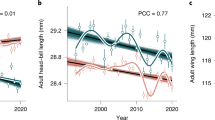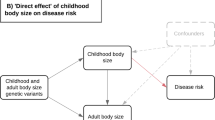Abstract
Human size is a tradeoff between the evolutionary advantages and disadvantages of being small or big. We now propose that adult size is determined to an important extent during transition from infancy to childhood. This transition is marked by a growth spurt. A delay in the transition has a lifelong impact on stature and is responsible for 44% of children with short stature in developed countries and many more in developing countries. Here, we present the data and theory of an evolutionary adaptive strategy of plasticity in the timing of transition from infancy into childhood to match the prevailing energy supply. We propose that humans have evolved to withstand energy crises by decreasing their body size, and that evolutionary short-term adaptations to energy crises trigger a predictive adaptive response that modify the transition into childhood, culminating in short stature.
Similar content being viewed by others
Log in or create a free account to read this content
Gain free access to this article, as well as selected content from this journal and more on nature.com
or
Abbreviations
- DICT:
-
delayed infancy to childhood transition
- GHD:
-
growth hormone deficiency
- IC:
-
infancy-childhood
- ICP:
-
infancy-childhood-puberty
- ISS:
-
idiopathic short stature
- SDS:
-
standard deviation score
- SGA:
-
small for gestational age
References
Muller GB 2007 Evo-devo: extending the evolutionary synthesis. Nat Rev Genet 8: 943–949
Hochberg Z 2008 Juvenility in the context of life history theory. Arch Dis Child [Epub ahead of print]
Bogin B 1999 Evolutionary perspective on human growth. Annu Rev Anthropol 28: 109–153
Bogin B 2002 The evolution of human growth. Cameron N Human Growth and Development. Academic Press Amsterdam 295–320
Washburn SL 1960 Tools and human evolution. Sci Am 203: 63–75
Singer D, Revenson, TA 1998 A Piaget Primer; How a Child Thinks. International Universities Press, Inc, Madison
Karlberg J, Engstrom I, Karlberg P, Fryer JG 1987 Analysis of linear growth using a mathematical model. I. From birth to three years. Acta Paediatr Scand 76: 478–488
Wang HS, Chard T 1992 The role of insulin-like growth factor-I and insulin-like growth factor-binding protein-1 in the control of human fetal growth. J Endocrinol 132: 11–19
Leger J, Oury JF, Noel M, Baron S, Benali K, Blot P, Czernichow P 1996 Growth factors and intrauterine growth retardation. I. Serum growth hormone, insulin-like growth factor (IGF)-I, IGF-II, and IGF binding protein 3 levels in normally grown and growth-retarded human fetuses during the second half of gestation. Pediatr Res 40: 94–100
Low LCK, Tam SYM, Kwan EYW, Tsang AMC, Karlberg J 2001 Onset of significant GH dependence of serum IGF-I and IGF-binding protein 3 concentrations in early life. Pediatr Res 50: 6 737–742
Karlberg J 1987 On the modelling of human growth. Stat Med 6: 185–192
Liu Y, Albertsson-Wikland K, Karlberg J 2000 Long-term consequences of early linear growth retardation (stunting) in Swedish children. Pediatr Res 47: 475–480
Van den Broeck J, Brand R, Massa G, Herngreen WP, Wit JM 2000 Length velocity acceleration at 9 months of age in a representative birth cohort of Dutch infants. J Pediatr Endocrinol Metab 13: 45–54
Rekers-Mombarg LT, Cole TJ, Massa GG, Wit JM 1997 Longitudinal analysis of growth in children with idiopathic short stature. Ann Hum Biol 24: 569–583
Liu YX, Jalil F, Karlberg J 1998 Growth stunting in early life in relation to the onset of the childhood component of growth. J Pediatr Endocrinol Metab 11: 247–260
Karlberg J, Albertsson-Wikland K 1988 Infancy growth pattern related to growth hormone deficiency. Acta Paediatr Scand 77: 385–391
Wit JM, van Unen H 1992 Growth of infants with neonatal growth hormone deficiency. Arch Dis Child 67: 920–924
Schmidt-Nielsen K 1975 Scaling in biology: the consequences of size. J Exp Zool 194: 287–307
Roff DA 2007 Contributions of genomics to life-history theory. Nat Rev Genet 8: 116–125
Arcaleni E 2006 Secular trend and regional differences in the stature of Italians, 1854–1980. Econ Hum Biol 4: 24–38
Karlberg J, Jalil F, Lam B, Low L, Yeung CY 1994 Linear growth retardation in relation to the three phases of growth. Eur J Clin Nutr 48( suppl 1): S25–S43; discussion S43–S24
Zverev Y, Chisi J 2004 Anthropometric indices in rural Malawians aged 45–75 years. Ann Hum Biol 31: 29–37
Darwin C 1859 The struggle for existance. On the Origin of Species by Means of Natural Selection or The Preservation of Favoured Races in the Struggle for Life. John Murray London 60–79
Kuzawa CW 2005 Fetal origins of developmental plasticity: are fetal cues reliable predictors of future nutritional environments?. Am J Hum Biol 17: 5–21
Xu X, Wang W, Guo Z, Karlberg J 2002 Longitudinal growth during infancy and childhood in children from shanghai: predictors and consequences of the age at onset of the childhood phase of growth. Pediatr Res 51: 377–385
Symonds ME, Gardner DS 2006 Experimental evidence for early nutritional programming of later health in animals. Curr Opin Clin Nutr Metab Care 9: 278–283
Anway MD, Cupp AS, Uzumcu M, Skinner MK 2005 Epigenetic transgenerational actions of endocrine disruptors and male fertility. Science 308: 1466–1469
Sollars V, Lu X, Xiao L, Wang X, Garfinkel MD, Ruden DM 2003 Evidence for an epigenetic mechanism by which Hsp90 acts as a capacitor for morphological evolution. Nat Genet 33: 70–74
Campbell JH, Perkins P 1988 Transgenerational effects of drug and hormonal treatments in mammals: a review of observations and ideas. Prog Brain Res 73: 535–553
Ellegren H 2000 Microsatellite mutations in the germline: implications for evolutionary inference. Trends Genet 16: 551–558
Moritz KM, Boon WM, Wintour EM 2005 Glucocorticoid programming of adult disease. Cell Tissue Res 322: 81–88
Melzner I, Scott V, Dorsch K, Fischer P, Wabitsch M, Bruderlein S, Hasel C, Moller P 2002 Leptin gene expression in human preadipocytes is switched on by maturation-induced demethylation of distinct CpGs in its proximal promoter. J Biol Chem 277: 45420–45427
Bouret SG, Draper SJ, Simerly RB 2004 Trophic action of leptin on hypothalamic neurons that regulate feeding. Science 304: 108–110
Waterland RA, Garza C 1999 Potential mechanisms of metabolic imprinting that lead to chronic disease. Am J Clin Nutr 69: 179–197
Waterland RA, Jirtle RL 2004 Early nutrition, epigenetic changes at transposons and imprinted genes, and enhanced susceptibility to adult chronic diseases. Nutrition 20: 63–68
Hermanussen M, Garcia AP, Sunder M, Voigt M, Salazar V, Tresguerres JA 2006 Obesity, voracity, and short stature: the impact of glutamate on the regulation of appetite. Eur J Clin Nutr 60: 25–31
Sawaya AL, Martins PA, Grillo LP, Florencio TT 2004 Long-term effects of early malnutrition on body weight regulation. Nutr Rev 62: S127–S133
Author information
Authors and Affiliations
Corresponding author
Additional information
K.A.W. is supported by a Swedish Research Council grant 7905.
Rights and permissions
About this article
Cite this article
Hochberg, Z., Albertsson-Wikland, K. Evo-Devo of Infantile and Childhood Growth. Pediatr Res 64, 2–7 (2008). https://doi.org/10.1203/PDR.0b013e318177590f
Received:
Accepted:
Issue date:
DOI: https://doi.org/10.1203/PDR.0b013e318177590f
This article is cited by
-
Novel type of references for BMI aligned for onset of puberty – using the QEPS growth model
BMC Pediatrics (2022)
-
Growth pattern evaluation of the Edinburgh and Gothenburg cohorts by QEPS height model
Pediatric Research (2022)
-
Novel type of references for weight aligned for onset of puberty – using the QEPS growth model
BMC Pediatrics (2021)
-
Estimating secular changes in longitudinal growth patterns underlying adult height with the QEPS model: the Grow Up Gothenburg cohorts
Pediatric Research (2018)
-
Growth hormone (GH) dose-dependent IGF-I response relates to pubertal height gain
BMC Endocrine Disorders (2015)



